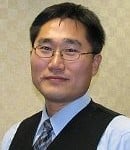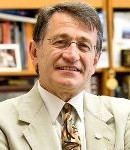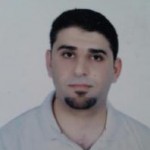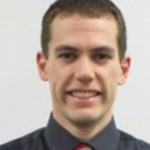 If seeing is believing, C.K. Choi (Adjunct Assistant Professor, Biomedical Engineering and Assistant Professor, Mechanical Engineering–Engineering Mechanics) has a passion for clarity—in a very tiny world. The assistant professor of mechanical engineering’s research lies at the micro-scale, in channels no thicker than a strand of hair.
If seeing is believing, C.K. Choi (Adjunct Assistant Professor, Biomedical Engineering and Assistant Professor, Mechanical Engineering–Engineering Mechanics) has a passion for clarity—in a very tiny world. The assistant professor of mechanical engineering’s research lies at the micro-scale, in channels no thicker than a strand of hair.
Read more —
 The ME-EM Graduate Seminar speaker on Thursday, December 4th at 4:00 in 103 EERC will be Dr. Renu Sharma from National Institute of Standards and Technology, Center for Nanoscale Science and Technology.
The ME-EM Graduate Seminar speaker on Thursday, December 4th at 4:00 in 103 EERC will be Dr. Renu Sharma from National Institute of Standards and Technology, Center for Nanoscale Science and Technology.
The title of her presentation will be ‘Correlative microscopy for in situ characterization of catalyst nanoparticles under reactive environments’.
In recent years the environmental transmission scanning electron microscope (ESTEM) has been success-fully employed to elucidate the structural and chemical changes occurring in the catalyst nanoparticles un-der reactive environments. While atomic-resolution images and the combination of high spatial and energy resolution is ideally suited to distinguish between active and inactive catalyst particles and identify active surfaces for gas adsorption, unambiguous data can only obtained from the area under observation. This lack of statistical information available from TEM measurements is generally compensated for by using other, ensemble measurement techniques such as x-ray or neutron diffraction, x-ray photoelectron spec-troscopy, infrared spectroscopy, Raman spectroscopy etc. However, it is almost impossible to create iden-tical experimental conditions in two separate instruments to make measurements that can be directly com-pared. Moreover, ambiguities in ESTEM studies may arise from the unknown effects of the incident elec-tron beam and uncertainty of the sample temperature. We have designed and built a unique platform that allows us to concurrently measure atomic-scale and micro-scale changes occurring in samples subjected to identical reactive environmental conditions by incorporating a Raman Spectrometer on the ESTEM. We have used this correlative microscopy platform i) to measure the temperature from 60 μm2 area using Ra-man shifts, ii) to investigate light/matter interactions iii) as a heating source, iii) for concurrent optical and electron spectroscopy such as cathodoluminescence, EELS and Raman. Details of the design, function, and capabilities will be illustrated with results obtained from in situ combinatorial measurements.
Renu Sharma is a Project Leader in the Nanofabrication Research Group. She received a B.S. and B.Ed. in Physics and Chemistry from Panjab University, India, and M.S. and Ph.D. degrees in Sol-id State Chemistry from the University of Stockholm, Sweden, where she had a Swedish Institute Fellowship. Renu joined the CNST in 2009, coming from Arizona State University (ASU), where she began as a Faculty Research Associate in the Department of Chemistry and Biochemistry and the Center for Solid State Science, and most recently served as a Senior Research Scientist in the LeRoy Eyring Center for Solid State Science and as an affiliated faculty member in the School of Materials and Department of Chemical Engineering. Renu has been a pioneer in the development of environmental scanning transmission electron microscopy (E(S)TEM), combining atomic-scale dynamic imaging with chemical analysis to probe gas-solid reactions. She has applied this powerful technique to characterize the atomic-scale mechanisms underlying the synthesis and reactivity of nanoparticles (including catalysts), nanotubes, nanowires, inorganic solids, ceramics, semiconductors, and superconductor materials. Renu has received a Deutscher Akademischer Austauschdienst (DAAD) Faculty Research Fellowship, is a past President of the Arizona Im-aging and Microanalysis Society, and has given over 70 invited presentations, and published 3 book chapters and over 160 research articles. At the CNST, Renu is establishing advanced E(S)TEM measurement capabilities for nanoscience re-search and contributing her research expertise to the operation of a new TEM facility in the NanoFab.
 Bill Predebon, chair of the Department of Mechanical Engineering-Engineering Mechanics, has been elected vice president for education of the American Society of Mechanical Engineers (ASME). The election took place on Nov. 14 at the ASME World Congress in Montreal.
Bill Predebon, chair of the Department of Mechanical Engineering-Engineering Mechanics, has been elected vice president for education of the American Society of Mechanical Engineers (ASME). The election took place on Nov. 14 at the ASME World Congress in Montreal.
Predebon joined the Michigan Tech faculty in 1976, after serving as a mechanical engineer at the US Army Ballistic Research Laboratory, Aberdeen Proving Grounds in Maryland. He has won Tech’s Distinguished Teaching Award, the W. R. Shapton Outstanding Service Award and the first annual Martin Luther King Award.
He designed and implemented a major curriculum revision for mechanical engineering-engineering mechanics, including the signature Senior Design program.
 The ME-EM Graduate Seminar speaker on Thursday, November 20th at 4:00 in 103 EERC will be Amer Tahat, PhD Student, Computational Sciences and Engineering, Department of Computer Science, Michigan Tech University,
The ME-EM Graduate Seminar speaker on Thursday, November 20th at 4:00 in 103 EERC will be Amer Tahat, PhD Student, Computational Sciences and Engineering, Department of Computer Science, Michigan Tech University,
The title of his presentation will be ‘Prototype Verification System PVS: Cutting Edges Human-Machine Interactive Verification, Modeling and Analysis Software’.
PVS is an interactive prototype verification system developed by SRI (Stanford Research Institute) with collaboration of NASA. PVS has been widely used by NASA to verify the correctness of their designs under extreme safety measures e.g Next Generation Air Traffic System (NextGen) and Scalable Processor-Independent Design for Extended Reliability (SPIDER). It has very powerful and ultra-reliable specification and semi-automatic verification language which can capture wide range of real world applications like complicated critical and autonomous control systems in: Aerodynamics, Robotics, Security and Communication Protocols. It also has been used for the design and the verifications of hardware and software of parametric critical systems, mathematical theories, and it was used even in modeling and analyzing meta-physical arguments! In this seminar we would like to introduce the revolutionary features of interactive analysis and verification system PVS. We will provide some examples of its applications in solving real life problems. Dr. Ossama Abdelkhalik (ME-EM department) and Amer Tahat PhD student (CSE) are planning to conduct a tutorial about this tool here at MTU with a generous collaboration of NASA Langley.
PVS received CAV award in 2012 ( 2012 CAV (Computer-Aided Verification) Award). PVS is an open source since 1994 and is known for its user friendliness. It has been used in industry as well as in academic research. For more information about related research fields please visit NASA formal methods group (http://shemesh.larc.nasa.gov/fm/fm-pvs.html), and PVS SRI website (http://pvs.csl.sri.com/index.shtml).
Amer Tahat is a Computational Sciences and Engineering PhD student, computer science department, at Michigan Tech University. I joined my PhD program in Sept 2012. In Oct 2012 I attended NASA Langley and National Institute of Aeronautics PVS (Prototype Verification System) class, in Hampton Virginia. Between Oct 2012 and March 2013 I was involved in a short project using PVS with the collaboration of NASA Langley. Since then I have been a member of Software Design Laboratory at Michigan Tech university and have been part of two projects under supervision of Dr. Ali Ebnenasir funded by National Science Foundation in which I study the applications of mechanical verifications using theorem prover PVS. Between 2012 and 2014, I attended and participated in several international conferences in formal and automatic verification techniques. In particular NASA Formal Methods Symposiums of Automatic Reasoning (NFM) NFM13, Moffett Field, Silicon Valley, CA and NFM14 in Johns Space Center, Huston, TX. Also in Sept 2014 I participated by a paper in LOPSTR 14 (24th International Conference of logic-Based Program Synthesis and Transformation) in UK.
In last summer 19-26 May 2014 I attended the Stanford Research International (SRI) forth summer school in formal techniques, Menlo College, Stanford, CA, in which assisted in organizing the student presentation secession. In the school I presented a PVS based analysis of a 1000 year metaphysical controversy http://fm.csl.sri.com/SSFT14/. I received an NSF generous award to attend this school.
Lately the work has been submitted to FSEN International Conference in Foundations of Software Engineering FSEN 15. Currently I am exploring more applications of PVS with the collaboration of Dr. Ossama Abedlkhalik ME-EM department on some other fields in Orbital Mechanics.
 Seven Michigan Tech students attended the Kiewitt Women’s Construction Leadership Seminar held in Omaha, Nebraska at the Kiewitt Corporate Headquarters November 6-8, 2014. Candidates were chosen from a pool of sophomores and juniors who have demonstrated leadership skills, a drive for success, and a passion for the construction and/or engineering professions. Kiewitt selected 50 collegiate female leaders to participate in the event designed to challenge and develop their leadership skills. Attending were civil engineering majors Emily Blaney, Lauren Krueger, Natalie Parker, Autumn Storteboom, and Rachelle Wiegand, along with mechanical engineering majors Erika Harris and Erin Richie.
Seven Michigan Tech students attended the Kiewitt Women’s Construction Leadership Seminar held in Omaha, Nebraska at the Kiewitt Corporate Headquarters November 6-8, 2014. Candidates were chosen from a pool of sophomores and juniors who have demonstrated leadership skills, a drive for success, and a passion for the construction and/or engineering professions. Kiewitt selected 50 collegiate female leaders to participate in the event designed to challenge and develop their leadership skills. Attending were civil engineering majors Emily Blaney, Lauren Krueger, Natalie Parker, Autumn Storteboom, and Rachelle Wiegand, along with mechanical engineering majors Erika Harris and Erin Richie.
UPDATE
Seven Tech Women Chosen for National Construction Leadership Seminar
 The ME-EM Graduate Seminar speaker on Thursday, November 14th at 4:00 in 103 EERC will be Dr. Steven Elmer from Michigan Tech: Department of Kinesiology and Integrative Physiology.
The ME-EM Graduate Seminar speaker on Thursday, November 14th at 4:00 in 103 EERC will be Dr. Steven Elmer from Michigan Tech: Department of Kinesiology and Integrative Physiology.
The title of his presentation will be ‘Positive Aspects of Negative Work’.
For over 100 years, scientists have been intrigued by the observation that skeletal muscle can produce greater absolute force during active lengthening contractions (“negative work”) compared to active short-ening contractions (“positive work”). In addition to this increased capacity for force production, negative work can be performed at a lower energy cost and with less perceived effort compared to positive work. Taken together, these observations emphasize the high-force, low-cost nature of negative work and sug-gest that exercise training involving negative work could serve as a potent stimulus for improving skeletal muscle function. In this presentation, I will discuss how negative work exercise training has served as an effective method for increasing quadriceps muscle size, strength, and mobility in a variety of populations ranging from patients with chronic disease to older adults to competitive athletes. Subsequently, I will share some preliminary work in which my group has extended the application of negative work to the upper body. Along the way, I will point out some mechanical design and safety challenges that we have encoun-tered while developing the negative work lower and upper body ergometers. By the end of the presenta-tion I hope to convince the audience that if an engineer from department trained for eight weeks using negative work exercise (e.g., 10-30 minutes/session, 3 sessions/week) they would be more powerful than a Tour de France winning cyclist! On that note this presentation will highlight the “positive aspects” of “negative work”.
Steven Elmer is a new Assistant Professor in the Department of Kinesiol-ogy and Integrative Physiology at Michigan Technological University. He completed his doctoral and post-doctoral training at the University of Utah and previously worked at the University of Maine. His research in-terests in health are broad in nature and he uses a cycling model to investigate as-pects of skeletal muscle function and dysfunction. Applications for his research range from basic aspects of neuromuscular function to applied human perfor-mance in a variety of settings including injury, rehabilitation, ergonomics, and sport. As a new member of the Husky Family Dr. Elmer looks forward to devel-oping collaborations across campus.
 The ME-EM Graduate Seminar speaker on Thursday, November 6th at 4:00 in 103 EERC will be Dr. Jeffrey Doering from Ford Motor Company.
The ME-EM Graduate Seminar speaker on Thursday, November 6th at 4:00 in 103 EERC will be Dr. Jeffrey Doering from Ford Motor Company.
The title of his presentation will be ‘Driveline Input Shaping via Clutch Torque to Mitigate Shuffle After Lash Crossing’.
We will use simplified 2nd order linear equations of motion for a driveline after lash crossing to evaluate different simple torque input schemes and derive an ‘optimum’ input ramping scheme to achieve a desired steady-state driveline torque level with a minimum level of oscillation. Due to the simplicity of the type of inputs considered, closed form solutions for the driveline response are developed and evaluated to yield physical understanding of the driveline management problem after a lash crossing event, especially to pre-vent driveline rebound or shuffle. Using the stiffness, inertia and level of damping in the driveline, normal-ized ramp rates and ramp times are developed to coordinate the torque input after lash crossing with the twisting of the driveline and the initial twisting velocity at the end of lash crossing.
Jeff Doering received the B.S. in Aerospace Engineering from the University of Minnesota, Minneap-olis, in 1991 and the M.S. in Mechanical Engineering from Stanford University in 1992. In 2000, Jeff received his Ph.D. in Mechanical Engineering from Michigan Technological University. Since 1992, he has been with Ford Motor Company, Dearborn, MI, working in the areas of engine and vehicle controls in both product development and research, where he is currently a Technical Leader in Research and Advanced Engineering.
Jeff currently leads a team of engineers working on vehicle and engine controls, primarily focused on HE-V/PHEV/BEV applications. Jeff has received over 90 U.S. Patents, with approximately 30 in production in Ford vehicles.
The General Motors Foundation has given Michigan Technological University a $100,000 grant through its University/Organization Partner Program. The gift will support a variety of student activities, including the Advanced Hybrid Electric Vehicle and Advanced Motorsports Enterprises, Environmental Engineering senior design programs, student groups and diversity initiatives.
Read More
The Society of Women Engineers (SWE) honored Michigan Tech alumnae Britta Jost and Kaitlyn Bunker at its annual conference, WE14, in Los Angeles last week. Jost received the SWE Distinguished New Engineer award, and Bunker was recognized as 2014 Outstanding Collegiate Member.
Read More
